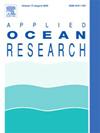Solitary wave-induced 2D seepage effects on sediment incipient motion
IF 4.3
2区 工程技术
Q1 ENGINEERING, OCEAN
引用次数: 0
Abstract
Solitary wave theory has been extensively applied to describe wave motions in very shallow water. Previous studies on sand movement induced by solitary waves have typically neglected the effects of seepage flow. This paper examines the effects of two-dimensional (2D) seepage on the Shields number using a semi-analytical model. A modified Shields number, incorporating seepage scaling factors, is derived to assess the influence of seepage forces on sediment incipience. It is found that wave-induced seepage can cause the maximum Shields number to increase by approximately 43.8 %, thereby promoting the incipience of seabed sediment. However, if only the vertical direction is considered, the downward "injection" force would reduce the Shields number. Ignoring the horizontal components of seepage may lead to an underestimation of seepage effects, potentially resulting in an inaccurate evaluation of sediment incipient motion. Parametric studies reveal that, under conditions of greater wave height, water depth, saturation, permeability, and lower Young’ s modulus, the maximum Shields number would noticeably increase due to the combined effects of horizontal and vertical seepage forces. The primary limitation is that the present results apply only to the laminar and partially transitioning regimes; further research is required for strong turbulence (Re > 5 × 10⁵).
求助全文
约1分钟内获得全文
求助全文
来源期刊

Applied Ocean Research
地学-工程:大洋
CiteScore
8.70
自引率
7.00%
发文量
316
审稿时长
59 days
期刊介绍:
The aim of Applied Ocean Research is to encourage the submission of papers that advance the state of knowledge in a range of topics relevant to ocean engineering.
 求助内容:
求助内容: 应助结果提醒方式:
应助结果提醒方式:


